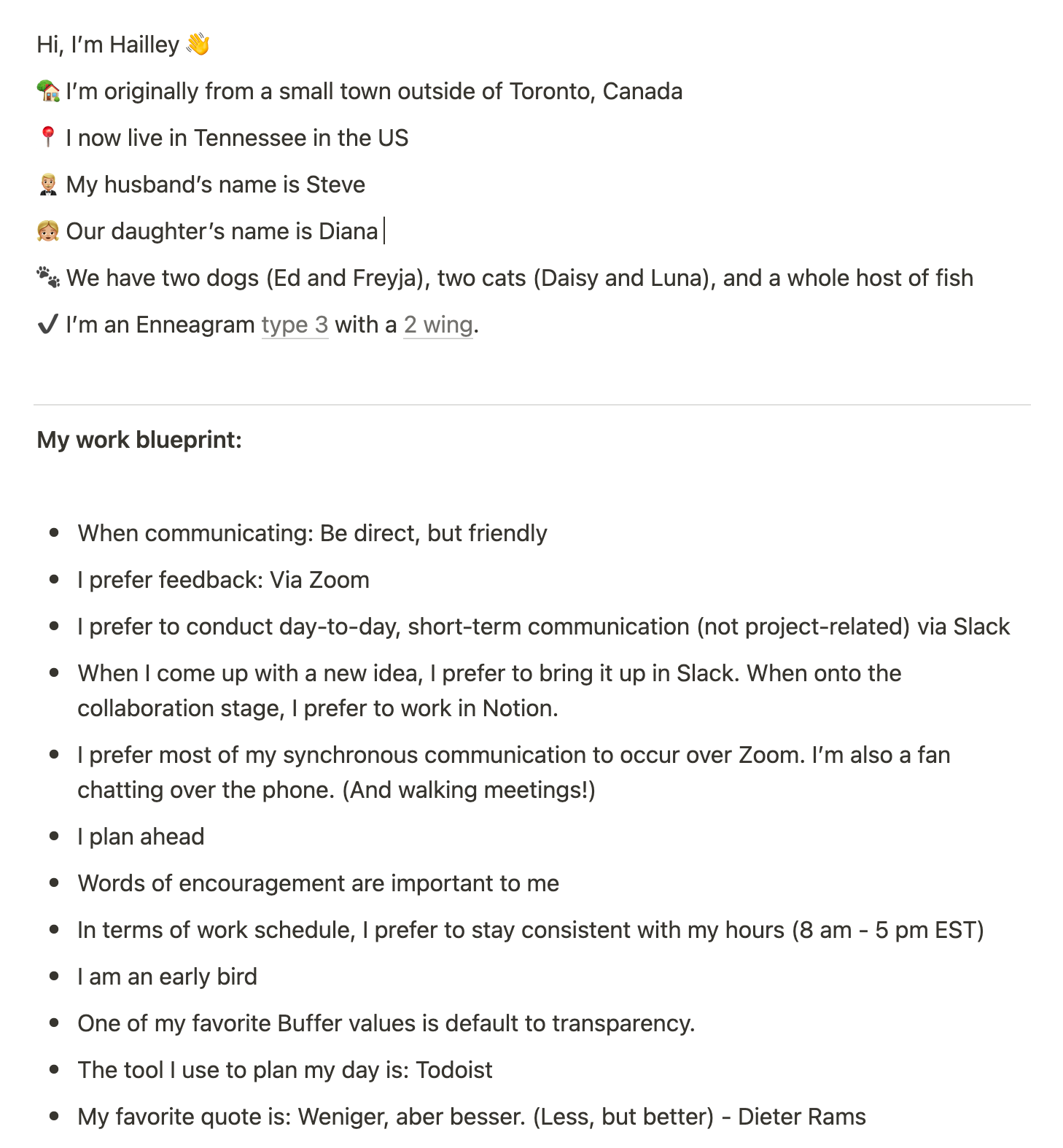
Work Blueprints: What They Are and How We Use Them at Buffer
Head of Communications & Content @ Buffer
Do you ever wish there was a shortcut to better understanding everyone you worked with? I definite have.
At Buffer, we've had assorted documents to communicate work preferences over the years. Some folks have kicked off specific documents called operating manuals or leadership blueprints. Still, we've never had anything centralized or standardized, which can be a superpower for this type of internal communication and collaboration, especially as a fully remote team.
Earlier this year, we decided it was time to make a simple template that any teammate could copy and reference in one place with work blueprints. In this post, I'll share more about our work blueprints, our exact template, and how we use them; let's dive in.
What is a work blueprint?
A work blueprint is our spin on what many in tech call user manuals, one-page sources of information about work preferences. We think of it as a shortcut for teammates to collaborate more efficiently by getting to know each other better. The blueprint is intended to shorten the learning curve for understanding how to work with someone else on your team, be it a peer, direct report, or manager.
We changed the name from user manual to work blueprint because the former felt a little too robotic for our team, and in the end, work blueprint has been just as catchy and self-explanatory.
How we set these up internally
We now host these blueprints in Notion. We have one spot where every teammate at Buffer is listed alongside their team and now their work blueprint is included, too.
Here's what mine looks like:


This way, everyone within Buffer has access to all work blueprints, and they are accessible in a centralized and already maintained and organized place.
Our work blueprint template at Buffer
We created a template to make these a lighter lift for anyone on the team. The template has specific prompts we encourage everyone to use. Included are also several optional prompts; everyone is welcome to make these as unique and custom as they'd like.
We have three kinds of prompts in this template:
- Sections we encourage every teammate to include
- Sections specifically for people managers
- Inspiration for sections to add that aren't required
Here's our exact work blueprint template:
About you: (Anything you want to include on the personal side of things)Social (and Start Page) links:Current location:Enneagram and/or Myers Briggs:Languages spoken:Any fun facts: (Favorite books, favorite baked goods, pets, awards, little-known facts.)
- When communicating: Be direct | Be ______
- I prefer feedback: Written | Written and then a video call | Video call
- I prefer to conduct day-to-day, short-term communication (not project-related) via [Slack | Threads | Zoom | Paper | Notion | Loom]
- When I come up with a new idea, I prefer to bring it up in [Slack | Threads | Paper | Notion | Loom]. When onto the collaboration stage, I prefer to work in [Slack | Threads | Paper | Notion | Loom].
- I prefer [all | most] of my synchronous communication to occur over Zoom. I'd also [love to try | am open to trying | am not a fan of] chatting over the phone.
- I plan ahead | I figure it out as I go
- Words of encouragement are important to me | I prefer ___ over words of encouragement
- In terms of work schedule, I prefer to stay consistent with my hours | prefer to work in a more flexible manner.
- What makes 1:1s most valuable to you?
Prompts for people managers
We added in additional questions for People Managers and Leaders who can share more about their overall leadership approach. Here they are:
- What is your leadership style?
- Need some inspiration? Here are thoughts from Indeed and Monster
- What should teammates expect in 1:1s?
- How do you want teammates to approach giving you feedback?
Other prompts and ideas for work blueprints
The above shares some basic information about someone's style, but there's so much more to that teammates might like to know. Here are some ideas we share as inspiration for customizing the work blueprint a bit more:
- I am: An early bird | A night owl | Neither early bird or night owl
- I identify with Ask culture | Guess culture (Here's an article and a Lead Dev talk video explaining these two options)
- One of my biggest strengths at Buffer is: __
- My days at work are always the best when ____ happens.
- It's not a great day for me when ____.
- One of my favorite Buffer values is ____.
- The tool I use to plan my day is: ____
- My favorite quote is _____.
- What do you need or expect from your manager | direct reports?
- What do you need or expect from your peers?
- What causes you to feel grumpy or stressed?
- How will others know when you're grumpy or stressed?
With these three sections, teammates are able to quickly put together a work blueprint that can give a clear picture of their work preferences, routines, and maybe even some things that their teammates wouldn't otherwise have known about them.
How do we use work blueprints at Buffer?
Kicking off the work blueprints project came from wanting teammates to easily share their work preferences in a straightforward place and for us to have one centralized location for this information internally.
When Darcy Peters, a Senior Customer Advocacy Manager at Buffer, and I initially kicked off this project, Darcy laid out three really clear use cases for work blueprints:
- As a team member, I've been able to read my manager's work document and discuss some aspects with her;
- As a manager, I've filled it out myself and created space for my team members to ask me questions about it;
- I've encouraged my team members to also fill it out so that I could understand them better. Great convos resulted!
All in all, the use cases can be summarized as:
- A team member can read their manager's
- A manager can read their team member's
- Mastermind partners can read one another's
- Partners on a project might want to read one another's, too
Here are a few more specifics about how we use the blueprints:
As individuals, we use them to better collaborate across the company.
Sometimes you have a preference that you haven't fully written down. Maybe you hate phone calls and it wasn't until you were prompted that you realized you much prefer seeing people's faces if you're going to be on a call. The work blueprints can offer a shortcut for collaboration and for sharing personal preferences in this way.
They are an excellent resource for people managers.
For people managers, work blueprints can be fantastic resources to reference during 1:1s with teammates, and on the flip side, for those managers to share more about their leadership and communication style with their immediate team.
They are especially beneficial to newer teammates.
On the Marketing team where I work, we are a primarily new team, with most of the team having joined in the last year. With that in mind, these work blueprints have acted as shortcuts to feeling like we can get to know each other better and start working more effectively together sooner.
Over to you
There are a lot of different names for what is ultimately a one-pager that can help people who collaborate work more efficiently together. So no matter what you call it, what would you add to the work blueprint we created? And what's the best example of this kind of work blueprint you've seen? Send us a tweet to share!
Try Buffer for free
140,000+ small businesses like yours use Buffer to build their brand on social media every month
Get started nowRelated Articles

How the Buffer Customer Advocacy Team set up their book club, plus their key takeaways from their first read: Unreasonable Hospitality by Will Guidara.

In this article, the Buffer Content team shares exactly how and where we use AI in our work.

Here we go again. If you work in social media, it’s nothing new to adapt and change your strategy based on the ever-changing algorithms and the rise and fall of social networks. (Who else was on Vine? 🙋🏻♀️) But, of course, we wish you didn’t have to. The latest wave for social media marketers and creators is that TikTok might be banned in the U.S. The short-form video app has become one of the most widely-used social media platforms and is credited with impacting trends and cultural shifts.